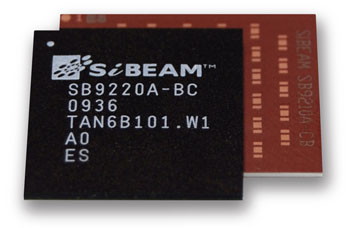Introduction

As I noted in my CES 2010 wrap-up, I spent a lot of time in meetings looking at wireless technology for HD media streaming. I looked at technologies for both in-room and whole house wireless HD distribution and came away with what I think are the winners in each category.
3D, Shmee D
But first, a word about all the hype around 3D TV at this year’s CES that I forgot to include in the wrap-up. This is the second year of what is sure to be a multi-year push by the CE biggies to force another upgrade cycle upon hapless consumers.
But we’re still recovering from a near economic disaster caused by the uber-greedy financial industry and lack of effective controls by (and political will of) governments world-wide. So most consumers have neither the inclination nor the money to throw out the HD gear they just purchased (or more likely went into hock for).
So I think the makers of shiny new 3D TVs (and the ancillary gear and content that goes with them) are going to have a tough time pushing this one through the pipe. Rather than do my own rant, I’ll point you to David Pogue’s Want It or Not, TV Goes 3-D piece in today’s N.Y. Times.
The only thing I’ll add is my impression of the actual 3D "experience" itself. Brief viewing sessions at the Sony, Samsung and Panasonic’s booths left me with the feeling that I’d see this effect before. Anyone remember the Viewmaster stereoscopic toy? Well, just picture that, but with moving rather than still images.
Most of what I saw was so obviously fakey that it was annoying. I felt like I was looking at a series of flat cut-outs, just stacked behind each other at varying depths. Only one of Panasonic‘s demos (the one with a woman playing with her dogs) came anywhere near providing a pleasant, view-enhancing effect.
No doubt that 3D, when done correctly, can enhance your viewing experience. I saw Disney / Pixar’s UP in 3D in a theater and liked the effect, which subtly imparted depth to the movie and didn’t distract at all from the story. Still, I probably would have enjoyed the movie just as much without the glasses.
Now that I’ve gotten that out of my system, on with the topic at hand.
Before I dig into the details, let me preface everything with the caveat that I’m reserving final judgement on everything I’m about to report on until I actually have products in-hand to test. Although I do some probing during demos, there simply isn’t time (nor vendor inclination), to let me dig as deeply as I’d like. While I seriously doubt that any vendor resorts to actual trickery for their demos, there certainly are optimizations that can be done to tip the scales in the demonstrator’s favor.
With that said, let’s take a tour through the four technologies I looked at: WirelessHD, WHDI, Quantenna’s 4×4 MIMO for Video and Atheros’ XSPAN with SST3 three-stream 802.11n. I’ll cover the first two in this Part 1 and the others in Part 2.
WirelessHD
I reported last year that WirelessHD looks like it may actually be a solution for people are looking to ditch the cables between their high-def TVs and the assortment of boxes that pump content to it. This year, it looks like WirelessHD could become the leading solution for in-room wireless High-Def distribution.
WirelessHD can transmit uncompressed HD video (1080p 60 Hz) and control information at rates up to 4 Gbps in a 10 meter range using wireless signals in the 60 GHz band. It uses beam forming and steering to dynamically steer the signal around obstacles.
This year’s news was the announcement of WirelessHD’s next-generation spec, which pushes raw data rates up to 28 Gbps, with actual bandwidth available to applications of double that of the 1.0 spec at around 10 – 15 Gbps.
Also added is support for 3D content and 4K resolution (yet another upcoming upgrade for CE manufacturers to foist on us) and HDCP 2.0 content protection. The latter will keep content owners happy and, along with DTCP in the 1.0 spec., enable WirelessHD to protect content whether it’s streamed or copied.
And speaking of copying, the enhanced spec also adds data transfer support for "sync ‘n go" transfers to portable devices, which have also received an enhancement via support for lower-power devices.
The addition of data transfer and TCP/IP support is intended to blunt the FUD from the Wireless Gigabit Alliance, which has been formed to rain on Sibeam and WirelessHD’s parade. WiGig’s main pitch is that it’s perfect for getting lots of data quickly and securely transferred to low-power portable devices, with less focus on in-room HD streaming.
In fact, at least from the WiGig proponents that I’ve heard from, WiGig seems laser-focused on painting WirelessHD as solely an HDMI cable replacement technology. But from the demo I saw, this doesn’t appear to be the case.
I was impressed by last year’s demo in a public demo room at CES. This year’s demo, in a private Sibeam (the primary developer of the Wi-HD chipset) hotel demo room, included both products you can buy (WirelessHD-equipped HD TV, Blu-ray player, HDMI adapter / bridge) and those you can’t yet (a notebook equipped with a WirelessHD adapter). All appeared to be singing and dancing happily together, without any glitches as people moved around the room and between connected devices.
The demonstrator was even happy to pick up the laptop, which was streaming HD content, and move to the back of the demo room, almost 30 feet away. He said they’d even tried the notebook out in the hallway with some success, but he didn’t risk that for me.
So, I’m once again impressed by WirelessHD and it appears that a good number of CE manufacturers are, too. A partial list includes HDTV’s from Panasonic, Sony, LG and Vizio and adapter sets from Monster, Gefen, Cables-to-Go and others.
And, oh yeah, so is Best Buy, which now fancies itself a VC, and has purchased a stake in Sibeam, the primary technology creator behind WirelessHD. Best Buy also is selling a $600 Rocketfish RF-WHD100 WirelessHD Adapter set using Sibeam devices.
For in-room wireless HD connectivity, it appears that WirelessHD has a two to three year lead on WiGig. That group just releasing its 1.0 spec this quarter (Q1 2010) and will be spending the next year developing a test plan, so that interoperability testing can begin sometime in 2011.
Certified devices may not be available until 2012 at the earliest, depending on whether WiGig will want to claim compliance with the upcoming 802.11ad spec. The current schedule for 802.11ad spec finalization is December 2012.
Of course, not everyone is going to rush out and spend a pile o’ money anytime soon for products with WirelessHD built in. And as long as WirelessHD adapter sets stay up around $600, consumers will give them a pass, too.

Sibeam WirelessHD HRTX chipset
For real consumer adoption, built-in WirelessHD will need to add only $20 – $50 to a product’s price and adapter sets need to come down to 11n or HomePlug AV pricing (~$80 / adapter, $150 / pair). The Sibeam folks made hopeful noises in this direction and the level of integration I saw for the devices (see above), made me hopeful, too.
WHDI

The Wireless Home Digital Interface (WHDI) group hasn’t really been on my radar screen. I’ve done only one news item on it, which was the announcement of the release of its 1.0 spec back in December.
I think WHDI’s off-my-radar status is because it uses 5 GHz band technology. Once 5 GHz Ultrawideband (UWB) technology acquired the stench of death due to Wireless USB’s failure, I lost interest in expensive 5 GHz-based HDMI adapter sets, no matter which technology they used.
But as Sibeam is to WirelessHD, so is chipmaker Amimon to WHDI. And the technology they use is definitely not UWB. Amimon says their technology supports delivery of "equivalent video data rates" of up to 3 Gbps (for uncompressed 1080p) in a 40MHz channel and rates up to 1.5 Gbps (for uncompressed 1080i and 720p) in a single 20MHz channel, in the 5 GHz band.
Folks in the HD transmission game love to talk about handling "uncompressed" streams, because the use of compression implies a sacrifice in image quality. Lack of compression is also a primary differentiator of 60 GHz-based technologies, which can deliver higher real application-level bandwidth.
But when the Amimon technical guru in the demo area heard my skepticism about WHDI’s uncompressed claims, he launched into a mini-tutorial on how it was possible. I don’t claim to be an expert on HD transmission. But the explanation sure sounded like there was some sort of heavy pre and post transmission processing involved in WHDI. So while it may not be compression, there is a lot of bit-twiddling involved to achieve that 1.5 to 3 Gbps for HD streams.
No matter. The demo suite had multiple rooms, demonstrating different WHDI applications. There was a data transfer demo to an iTouch that had a large reference-design looking adapter strapped to it and a video streaming to a HDTV with WHDI adapter built in.
Another room had a side-by-side comparison demo of an HD video streaming via WHDI and HDMI cable, so that you could play find-the-cable. And the big room had a multi-device demo where they could demonstrate "follow-me" capability from one STB to another (pause video on one TV and resume on another).
A rep. for a competing technology characterized WHDI as an HDMI replacement technology trying to reposition itself as a "whole home" technology. I think "whole home" is an optimistic positioning for a technology whose range is spec’d as "100 feet, through walls". I should also note that none of the demos that I saw included WHDI signals traveling across even a single room wall.
But whether it’s for HDMI replacement or whole-home distribution, I suspect that WHDI may have its work cut out for it to win mind-share over its 60 GHz based competition. However, WHDI’s weakness is also its strength, since 5 GHz signals can get through media cabinet doors, while 60 GHz signals cannot and this may increase its spousal-approval index.
The big news in WHDI’s favor at CES was Amimon’s announcement that LG is coming out with HD TV’s and accessories using Amimon’s second generation WHDI chipset. The WHDI folks characterized this as LG throwing out WirelessHD, which LG included in some of its sets last year. But I think it’s more a case of LG, like all other CE vendors, continuing to spread its bets among competing technologies.
WHDI certainly doesn’t have a lead over WirelessHD in terms of price. HDMI replacement adapter pairs are still up around $600 or so, although I was told this would be coming down to the $200 – $300 range shortly.
Finally, I always judge a technology’s readiness for prime-time by a company’s reaction when I ask them for product to review. After all the rah-rah and chest-thumping the WHDI rep did during the demos, he was strangely silent when I asked him to send me WHDI product to test. That, to me, says more than any demo he could have shown. To be fair, however, although I didn’t also ask the WirelessHD folks for product to test, they didn’t volunteer any, either.
Next time, I’ll wrap this up with a look at Quantenna’s impressive 4×4 MIMO solution and Atheros’ three-stream N.

